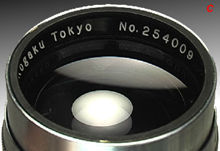|
|
|||||||||||||||||||||||||||||||||||||||||||||||
Additional information on
Nikon (Nippon Kogaku) RF Nikkor-Q 1:4 13.5cm in Chrome/Brass & Black Paint versions
for Nikon S-bayonet mount rangefinder cameras - Part II
HTML File Size: 135k Loading ... 3rd draft 23.05.2011

Although all along Nikon has no info provided on the 135/4 but they did with more confidently with the 135/3.5, it uses 4 elements 3 group optical design as shown above. We would assume all the 135/3.5 would share the same.
Generally, the early production Nikkor-Q.C 1:3.5 f=13.5cm Nippon Kogaku Tokyo, MIOJ version still offered f/16 minimum aperture, chrome/brass combination , slightly enlarged lens tube with a more refined depth of field scales than the f4 predecessor. Although there are references such as Robert Rotoloni's description of which the earliest batch which carries with S/N 5006x(xx) had "Made in Occupied Japan" (MIOJ) wordings still presented on the lens barrel, but most which had surfaced today, especially the 25-xxx f/16 series were partly hidden, engraved at the outside of the lens cam at the rear end mount section.
Another less noticeable and less significant change was at the tripod collar, where only 2 screws were used instead of 3 to fasten the socket firmly. Note: The socket may be different and "Made in Japan" may be engraved on the models.
During the first quarter of the 1950,the photographic community had started to take notice of emergence of the Nikon as well as excellent series of optic the Company had produced, one reason was its modest price and was a good alternate to Leica and Contax. The Nikkor-Q.C 1:3.5 f=13.5cm telephoto, like many other Nikkor, had been produced in other mount such as LSM and Contax bayonet (even for Exacta !). The lens hood is two-piece design, metal front cap is screw-in onto metal hood after reverse mounting.
Amidst the period during the early '50 with some of the lenses introduced were quite confusing. There were Nippon Kogaku Tokyo, Nippon Kogaku Japan, MIOJ , a mixed and so forth, even the serial numberings appeared may have different coding for markets. Shown above is a Contax mount 135/3.5, the unit with reversible stored lens hood attached (A) has a mystical ":" at the end (B) it was encoded as "S/N 255245 : "); while another Tokyo version which has no filter thread at the front ring (C) S/N 254009).

Confusion, sometimes may tell you a lot of things. It may reflect the state of Nikon was experienced during the period, it may explained as their inability to cope with sudden surge of sales, overstock or shortages of individual parts, indirectly also had mirrored weak management in coordination among design, marketing and manufacturing departments or even may explained as struggling to establish a proper control system for inventories and/or products for respective markets in mass production way etc. Personally, I would think the Company was not entirely prepared for the sudden draw of international attention to their products in a mass demand manner. If we used the earliest 135/4 poor sales of approx. 900 units from 1948~1950, 3,000 for the first 135/3.5 between 1950~1953, it was already a three folds jump in sales. The f/32 upgrade with intermixed chrome and chrome/black model has even surged to 12,000 units between 1953~1956 , another 4 folds from the first 135/3.5 model ! Sales figures ref: Nikon Rangefinder Camera by R.Rotoloni.
Note: by the way, Nico & I had worked together earlier in a project to compile the Nikkor F-mount 50mm version history in an orderly manner, he is incredibly knowledgeable with the Nikon stuff ! As for other possible combinations, also read HERE.
Nikon S-mount Nikkor-Q.C 1:3.5 f=13.5cm Black PaintThe first radical change to the traditional all chrome/brass appearance of the Nikkor-Q.C 1:3.5 f=13.5cm probably was happened between 1954/55. Popular referred as "black lens" 135/3.5, essentially it is the same lens with the chrome on brass version except a black paint is coated on surface. The weight is also close to the original chrome on brass version, except in some cases the combined weight with accessories would make the package lighter (typically chrome/brass combination weighs approx. 545g, the subsequent black version which mainly use aluminum weighs very much lighter at approx. 390g only. So, to be more appropriate, you can also call it as a Nikkor-Q.C 135/3.5 black paint version. The black paint version could had been provide matched appearance for growing number of black Nikon rangefinder cameras from there on.
| previous | NEXT | 2/4 the last series, Nikkor-Q.C 1:3.5 f=13.5cm Black w/info on accessories and technical specifications
Nikkor-Q.C 1:4 f=13.5cm | Nikkor-Q.C 1:3.5 f=13.5cm Chrome / Nikkor-Q.C 1:3.5 f=13.5cm Black Paint | Nikkor-Q.C 1:3.5 f=13.5cm Black / spec /accessories | Bellow-Nikkor 1:4 f=13.5cm
Nikon RF-Nikkor lenses (Rangefinder):- Main Index Page
Nikon Auto Focus Nikkor lenses:- Main Index Page
Nikon Manual Focus Nikkor lenses:- Main Index Page
Nikon F | Nikon F2 | Nikon F3 | Nikon F4 | Nikon F5 | Nikon F6 | Nikkormat / Nikomat | Nikon FM | Nikon FE/ FA | Nikon EM/FG/FG20 | Nikon Digital SLRs | Nikon - Other models | Back | Main Index Page of Pictorial History of Nikon SLRs
about this photographic web site
Credit:- Special thanks to all the contributors of images and content which made up the basis of the site. Note:certain content and images appeared in this site were either scanned from official marketing leaflets, brochures, sales manuals or publications published by Nikon over the years and/or contribution from surfers who claimed originality of their work for educational purposes. The creator of the site will not be responsible for may discrepancies arise from such dispute except rectifying them after verification."Nikon", "Nikkormat", "Nippon Kokagu KK" & "Nikkor" are registered trade name of Nikon Corporation Inc., Japan. Site made with an Apple G5 IMac.